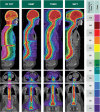How proton therapy fits into the management of adult intracranial tumors
- PMID: 38437667
- PMCID: PMC10911801
- DOI: 10.1093/neuonc/noad183
How proton therapy fits into the management of adult intracranial tumors
Abstract
Intracranial tumors include a challenging array of primary and secondary parenchymal and extra-axial tumors which cause neurologic morbidity consequential to location, disease extent, and proximity to critical neurologic structures. Radiotherapy can be used in the definitive, adjuvant, or salvage setting either with curative or palliative intent. Proton therapy (PT) is a promising advance due to dosimetric advantages compared to conventional photon radiotherapy with regards to normal tissue sparing, as well as distinct physical properties, which yield radiobiologic benefits. In this review, the principles of efficacy and safety of PT for a variety of intracranial tumors are discussed, drawing upon case series, retrospective and prospective cohort studies, and randomized clinical trials. This manuscript explores the potential advantages of PT, including reduced acute and late treatment-related side effects and improved quality of life. The objective is to provide a comprehensive review of the current evidence and clinical outcomes of PT. Given the lack of consensus and directives for its utilization in patients with intracranial tumors, we aim to provide a guide for its judicious use in clinical practice.
Keywords: CNS tumors; brain tumors; proton therapy.
© The Author(s) 2024. Published by Oxford University Press on behalf of the Society for Neuro-Oncology. All rights reserved. For permissions, please e-mail: journals.permissions@oup.com.
Conflict of interest statement
R.K.: Honoraria from Accuray Inc., Elekta AB, ViewRay Inc., Novocure Inc., Elsevier Inc., Brainlab, Kazia Therapeutics, Castle Biosciences, and Ion Beam Applications and institutional research funding from Medtronic Inc., Blue Earth Diagnostics Ltd., Novocure Inc., GT Medical Technologies, AstraZeneca, Exelixis, ViewRay Inc., Brainlab, Cantex Pharmaceuticals, Kazia Therapeutics, and Ion Beam Applications. A.L.R.: Travel/reimbursement by GT Medical Technologies. M.P.M.: Consulting Fees from Karyopharm, Sapience, Zap, Mevion, Xoft; Kazia Therapeutics; BOD Oncoceutics; Stock in Chimerix
Figures


References
-
- Lomax AJ. Charged particle therapy: The physics of interaction. Cancer J. 2009;15(4):285–291. - PubMed
-
- Dutz A, Agolli L, Bütof R, et al. . Neurocognitive function and quality of life after proton beam therapy for brain tumour patients. Radiother Oncol. 2020;143:108–116. - PubMed
-
- Laack NN, Brown PD, Ivnik RJ, et al. ; North Central Cancer Treatment Group. Cognitive function after radiotherapy for supratentorial low-grade glioma: A North Central Cancer Treatment Group prospective study. Int J Radiat Oncol Biol Phys. 2005;63(4):1175–1183. - PubMed
Publication types
MeSH terms
LinkOut - more resources
Full Text Sources
Medical

